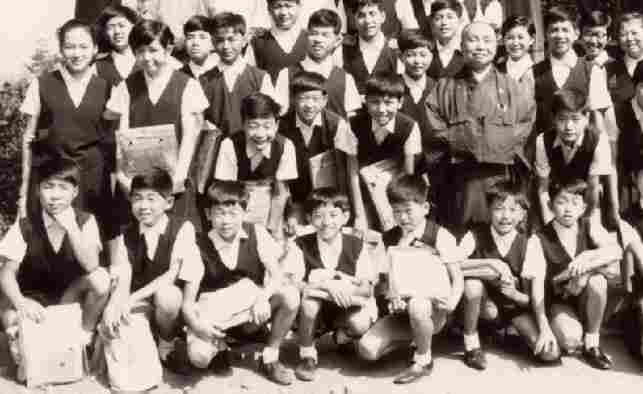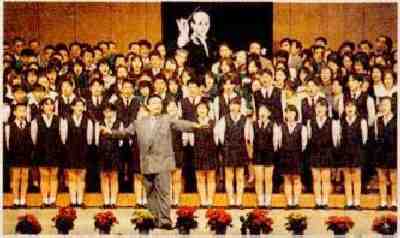
Figure 1.--The Nishi-rokugo boys and girls chorus is pictured here, probably in the late 1960s. It was a mixed choir with relatively equal numbers of boys and girls. Click on the image for a fuller view.++++
The Nishi-rokugo boys and girls chorus was one of the relatively few
mixed groups with a substantial number of boys participating. HBC contributors report
that this was primarily because the choristers were individully selected by the director,
Mr. Kamata. A former chorister reports that Mr. Kamata admired the European boys choirs
like the famous Vienna boys choirs. Thus he always made sure boys as well as girls were
selected for his choir.
This group was one of most famous children's chorus group in Japan.
The Nishi-rokugo boys and girls chorus dissolved in May, 1999 because Mr.
Kamata (music-teacher of Nishi-rokugo Junior school and
conductor of this chorus) died was dead at a hospital in Tokyu Ota-ku. One of the old boys
of the choir report informs HBC that he always said, "When I die, the the chorus hove to stop the action."
A new New-Nishi-rokugo boys and girls chorus is reportedly being formed.
The choir wore the same basic uniform for over 30 years. A former chorister in
the 1970s reports that the boys liked the choir uniform as it was comfortable and simple.
The simplicity made it easy to maintain.
The choir in the late 1960s wore short sleeved white shirts. The boys
are not wearing ties, but this may be because they are on an outing. Most of the members buttoned their collars, but many did not. They wear dark-colored "V" neck,
sleevless sweaters. The boys wear black or dark colored
short cut short pants the girls wore skirts of a matching color, but much longer. The
boys wear white ankle socks and black leather shoes.
not.

Figure 2.--The Nishi-rokugo boys and girls chorus is pictured here in 1999. The uniform changed little over the years. This was the last concert and both current and former choristers participated. Director Kamata died before the concert and the performance was dedicated to him. The large photo on the wall is the late Mr. Kamata. |
A photograph taken in the 1990s shows an almost identical uniform. Unlike the earlier
uniform, by the 1990s, the girls wore short skirts, approximately matching the boys'
shorts in length. The boys wear
ties, but the girls do not. Other than these minor differences, the uniform look identical to the one worn 30 years earlier.
The choir sang children's songs, some collections, and a variety of popular songs.
The choristers were individually recruited by Mr. Kamata. One HBC contributor reports that in the late 1960s when he joined the choir, there was an annual entering ceremony.
On a Spring day every year, Mr. Kamata gathered boys and girls in the 3rd or 4th grade of his junior [elementary] school. He heard each children's singing voice, and selected children to
join the choir. "I was honored to be selected and agreed to join." Many boys are incouraged by their mothers to join a choir, but this was not always the case.
One HBC contribuor reports, "I have lots of happy memories of the choir and Mr. Kamata.
There were consert tours, Christmas conserts, TV-show, and so on." If you speak Japanese,
they are described on the contributors home page.>>>>
Nishi-rokugo experiences.
Navigate the Historic Boys' Clothing Web Site:
[Introduction]
[Chronologies]
[Style Index]
[Biographies]
[Bibliographies]
[Contributions]
[Activities]
[Countries]
[Boys' Clothing Home]
Navigate the Historic Boys' Clothing Japnese pages:
[Main Japanese page]
[Japanese monarchy]
[Japanese school uniform]
[Japanese scouts]
[Japanese choir page]
[Japanese music recitals]
[Japanese department
stores]
Navigate the Historic Boys' Clothing Web choir costume pages:
[Return to the Main Japanese choir page]
[Return to the Main choir page]
[Australia]
[Austria]
[Belgium]
[Bulgaria]
[Denmark]
[England]
[France]
[Finland]
[Germany]
[Ireland]
[Netherlands]
[New Zealand]
[Poland]
[South Africa]
[United States]